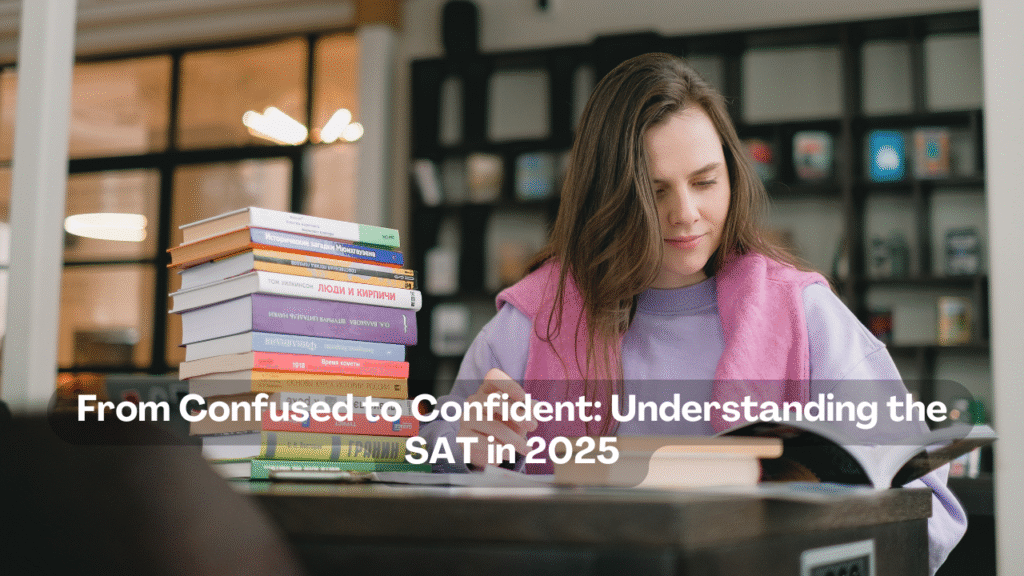From Confused to Confident: Understanding the SAT in 2025

What is the SAT Exam? For millions of teens, those three letters mark the bridge between high school and their dream university. In the most recent testing year, 1.9 million students from more than 175 countries sat for the SAT, generating score reports that were sent to over 4,000 colleges worldwide.
Despite the rise of test-optional admissions, 83 percent of U.S. colleges still consider standardized test scores when awarding merit aid or placing students in freshman courses. In other words, the SAT continues to influence scholarship dollars, course placements, and acceptance decisions, especially for international applicants whose school curricula vary.
I’ve spent the last decade helping families decode the fine print of college admissions. This guide distills that experience into actionable insights: timelines that work, strategies that move the needle, and pitfalls you can dodge. Whether you’re a Grade 10 student mapping out your first practice test or a results-driven parent hunting for the best return on investment, you’ll find a clear roadmap below.
Table of Contents
- The Origin and Evolution of the SAT
- Who Should Take the SAT and Why It Matters
- What Subjects and Skills the SAT Exam Tests
- How the SAT Fits into U.S. and Global College Admissions
- When and How Often You Can Take the SAT
- SAT Scoring System: Understanding Your Score Report
- Digital SAT in 2025: What’s Changed for Test-Takers
- SAT Registration: Steps, Documents, and Fee Details
- How Parents Can Support Their Child’s SAT Journey
- Common Mistakes First-Time SAT Takers Should Avoid
1. The Origin and Evolution of the SAT
Born in 1926 as the Scholastic Aptitude Test, the SAT aimed to democratize access to elite colleges by offering a single, standardized benchmark. Over the decades, the exam has morphed from a 2,020-point scale to today’s 1,600-point format, scrapped its obscure “analogy” questions, and, most recently, transitioned to a fully digital, adaptive model. Every change reflects a broader shift in what higher-education gatekeepers consider “college readiness.” Understanding that history helps you see why, even in test-optional times, a stellar SAT score still speaks volumes.
2. Who Should Take the SAT and Why It Matters
If you’re eyeing competitive scholarships, engineering majors, or U.S. universities with holistic review, the SAT belongs on your to-do list. A score in the top decile (about 1350+) can shave $5,000 to $25,000 per year off tuition at many state flagships. International applicants benefit even more, as a strong SAT eases comparability across diverse curricula and grading scales. And because Score Choice lets you send only your best performance, there’s little downside to sitting for the exam more than once.
3. What Subjects and Skills the SAT Exam Tests
The SAT measures two core domains:
- Evidence-Based Reading & Writing (EBRW) – Grammar, rhetoric, vocabulary-in-context, and analysis of short passages.
- Math – Algebra I/II, problem-solving, data analysis, and a dash of geometry/trigonometry.
Each section is scored 200-800. Sub-scores reveal granular strengths, think “Command of Evidence” or “Heart of Algebra”, helping you target prep efficiently.
4. How the SAT Fits into U.S. and Global College Admissions
Selective U.S. campuses still publish middle-50 percent SAT ranges for admits (Ivy League medians hover around 1510). Canadian and Singaporean universities use SAT scores to supplement national exams, while top Indian private colleges accept the test for “direct admission” tracks. Even test-optional schools may use high scores to determine course placement or honors-program eligibility. In short, a robust SAT result remains a versatile currency in the global admissions marketplace.
5. When and How Often You Can Take the SAT
The SAT is offered seven times worldwide: March, May, June, August, October, November, and December. Most juniors sit for their first official test in spring, leaving summer for targeted prep and a fall retake. Data from the College Board shows that 67 percent of students improve their total score on a second attempt. Thanks to superscoring, colleges typically combine your highest EBRW and Math marks across dates, another reason to aim for at least two sittings.
6. SAT Scoring System: Understanding Your Score Report
| Component | Score Range | Why It Matters |
| Total Score | 400-1600 | Snapshot of overall college readiness |
| EBRW | 200-800 | Reading comprehension and writing mechanics |
| Math | 200-800 | Algebraic fluency and data analysis |
| Percentile | 1-99 | How do you stack up against your peers |
A 1350 places you in roughly the 90th percentile nationally. Colleges also read your Cross-Test and Sub-Score breakdowns to identify subject strengths, making the score report a surprisingly detailed prep roadmap.
7. Digital SAT in 2025: What’s Changed for Test-Takers
Say goodbye to bubble sheets. The digital SAT is now just over two hours long, features shorter reading passages, and allows a built-in Desmos graphing calculator for every Math question. Adaptive modules mean the difficulty level shifts after your first section, tailoring questions to your performance. Scores arrive in days instead of weeks, accelerating scholarship and application timelines. For prep, this demands on-screen annotation practice and a focus on time-efficient reading strategies.
8. SAT Registration: Steps, Documents, and Fee Details
- Create a free College Board account.
- Upload an acceptable photo ID (passport or driver’s license).
- Choose your test date and center early, slots fill fast in metro areas.
- Pay the base fee ($60 in 2025) plus regional surcharges if applicable.
- Apply for fee waivers if you qualify; they cover two tests and unlimited score reports.
Early registration unlocks prime centers and minimizes travel stress, especially important for international test takers who may face limited seating.
9. How Parents Can Support Their Child’s SAT Journey
Think of yourself as the project manager, not the test taker. Provide structure: a 24-week timeline, dedicated study space, and weekly check-ins. Celebrate incremental gains, every 50-point jump can equate to thousands in merit aid. Leverage free resources like the SAT Mock Test to benchmark progress. Above all, safeguard sleep and mental health; burnout is the silent score killer.
10. Common Mistakes First-Time SAT Takers Should Avoid
- Cramming instead of spaced practice.
- Skipping full-length mock exams (schedule one every three weeks).
- Ignoring the official answer explanations.
- Arriving without an approved photo ID.
- Underestimating the no-calculator Math module, practice mental math daily.
Frequently Asked Questions
1. Why does the SAT still matter if many colleges are test-optional?
Test-optional means the score isn’t required, but a strong result can tip the scale for merit aid, honors programs, and tie-breaker decisions.
2. How hard is the digital SAT compared to the paper version?
Difficulty levels are calibrated to remain consistent. Most students say the shorter format feels less tiring, and adaptive modules reduce repeated concepts.
3. Can I take the SAT more than twice?
Yes. Many students sit three times; superscoring ensures colleges see only your best section results.
4. What calculators are allowed?
The digital platform includes Desmos, but you may also bring approved graphing calculators. Check the College Board’s official list.
5. How soon are scores released?
Digital scores typically appear within one week, expediting scholarship applications.
6. Is the essay still required?
No. The SAT essay was discontinued in 2021; colleges now rely on your application essays for writing assessment.
7. What is a good SAT score for Ivy League schools?
Aim for 1500+ to stay competitive, but remember holistic review also weighs GPA, essays, and extracurriculars.
8. When should international students take the SAT?
Ideally, by October of Grade 11, allowing time for retakes and score reporting before early-decision deadlines.
Primary Sources
Conclusion
The SAT isn’t just an exam; it’s a leverage point in today’s competitive admissions arena. A single Saturday morning can unlock scholarships worth five or even six figures, tip a borderline application into the admit pile, or fast-track you into honors seminars that save tuition and add résumé polish. Remember, 83 percent of colleges still use test scores for at least one decision, from merit aid to course placement.
Your journey starts with a realistic timeline, strategic practice, and data-driven adjustments. You now have the roadmap, anchored in up-to-date statistics, tried-and-true strategies, and insider context from years in the admissions trenches. Ready to see where you stand and how high you can climb?
Take our free SAT Practice Test today and receive a personalized score report, complete with targeted next steps. Your dream college is waiting; let’s make that acceptance letter a reality.
